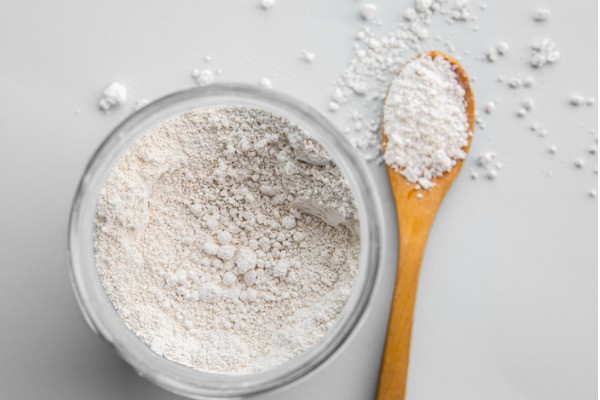Diatomaceous Earth
Diatomaceous Earth is a great natural alternative for cats and dogs to combat fleas, worms or parasites.

www.authenticapets.com
Diatomaceous earth is often associated with treating garden pests, however, it can also be a great natural alternative to using chemical based treatments to give your cat or dog, especially to help combat internal worms, fleas and parasites.
Diatomaceous earth is a chalky powder that is virtually pure amorphous silica, made from the fossilizing of tiny marine organisms, diatoms, that are found in freshwater rivers and lakes. DE is generally famous for attacking bugs such as slugs or those critters that have a soft body but it can be used as a natural insecticide or detox agent for your pet. It's not without some risks but if used correctly, the benefits far outweigh the risk and quite frankly, it's far less harmful to your cat and dog's long term health than over the counter treatments prescribed or recommended for parasites, fleas and worms.
There are many commercial products but for the safety of your pet, you'll need food grade diatomaceous earth. If it's not for human consumption, avoid using it with your pet as it will cause harm. Remember if it's good enough for you to take, it's good enough for your pet, anything else is toxic to their body.
Benefits of Diatomaceous Earth
Eliminates, fleas, mites and ticks
Detoxes your pet's body of parasites
Helps eliminate intestinal worms i.e. roundworms, hookworms, pinworms, lungworm
Helps cleanse the digestive system
Provides some trace minerals
Helps with the removal of heavy metals
Helps with skin issues
Helps with digestive issues
By aiding the digestive system it helps improve liver function
Helps improve overall nutrient absorption
Natural source of silica
Is Diatomaceous Earth Safe for Pets?
Yes, it's been around for 1000's years, it's natural and it's far safer than chemical-based flea treatments that pose long-term health effects in cats and dogs. It's essential you buy and use food grade diatomaceous earth. Ensure the DE you buy has not been mixed with anything else or undergone any treatments whereby synthetics or other artificial substances have been added to the powder. Go exclusively for the food grade natural product, anything else will harm your pet.
Best used as a supplement and or as a flea treatment. Avoid feeding daily as part of your pet's diet. You may want to feed it as a supplement for a short timeframe but ideally, your pet's raw food diet should contain the full scope of nutrition needed by your cat or dog without having to add too many supplements into their diet.
Use diatomaceous earth as a parasitic/worm/digestive cleanse once or twice a year. Ideally in line with spring and autumn, as these seasons prep the body for the season ahead and help your pet build natural defences.
Or use as a flea treatment when needed, i.e if your pet begins to have an issue with fleas, ticks, scratching etc. apply diatomaceous earth. If your pet is healthy and is fed a species appropriate diet you will not need to apply monthly flea treatments. You'll use diatomaceous earth just when required.
Ensure there are no contraindications with any medication.
Do not use with kittens or puppies under 3 months unless under the guidance of a holistic vet.
Side Effects
If your pet's condition worsens or does not improve speak with your integrative vet.
Avoid directly breathing in the powder. Precautions should be taken with animals with lung and eye issues as in some cases, it can be an irritant
Not recommended for pregnant or nursing pets.
May cause dehydration in some pets
May cause constipation or bloating
How to Give Diatomaceous Earth For Cats & Dogs
Forms of use:
Powder
Administration can be via
Can be given orally as a supplement
Can be applied topically as a flea, tick treatment
Diatomaceous Earth For Dosage for Pets
Cats & Dogs
Diatomaceous earth is highly absorbent. Keep it in a cool place away from direct sunlight and in an airtight container to maintain its integrity.
Diatomaceous earth is a great natural product and food grade DE can aid your pet's health but dosages and how it is administered will depend on what issue you're treating with your cat or dog.
It's best to consult with your integrative or holistic vet for your pet's individual health needs to ensure healing occurs, especially if using DE to aid detoxing.
For external use: As a preventative, get a salt shaker and pop some food grade diatomaceous earth into the shaker and sprinkle a light dusting on your cat or dog's fur. Go for the neck area to prevent your cat or dog from licking it off directly, you can also sprinkle some directly onto your pet's collar. If you sprinkle some at the base of the tail, just know that your pet is likely to lick it off. Ideally, rub the fur the wrong way, sprinkle, massage in then rub the fur the correct way. Try to get it as close to the skin as possible.
To combat fleas: Can work well in combination with ACV and rosemary water flea spray, click here for the recipe. Use a flea comb to dislodge as many fleas as possible using either the rosemary or lemon flea dip - click here. Then apply the homemade apple cider vinegar spray. Wipe off any excess or massage it into your pet's fur but leave your pet to dry naturally.
When your pet's fur is dry sprinkle on the diatomaceous earth. Do this daily until your pet no longer has fleas. Once you've got rid of the fleas, continue with the treatment for another 3 to 5 days depending on the severity of the infestation but you want to ensure you've got rid of the fleas and any eggs. Then for a few weeks thereafter you can either use the ACV spray or apply diatomaceous earth or use a combination of both. This works well for both cats and dogs. With diatomaceous earth always apply a light dusting only.
You can also spray your pet's bed with the vinegar mix and leave it to dry completely naturally in the sun, then sprinkle DE on their bed, patting off any excess. Avoid using the DE if the bed is still damp.
Don't go overboard when using diatomaceous earth. A little goes a long way.
General-purpose guidelines. Internal Use;
For parasites and worms: Feed your pet at least an hour away from food and before feeding times. It's best administered on an empty stomach. You'll need to do this over a period of weeks to eliminate the cycles for both the adults and kill off any eggs.
It's essential that once you start, you don't break the cycle so that you can flush out the worms, parasites etc. if left in the body, they can cause toxicity problems for your dog or cat. Work with your integrative vet to determine the length of time needed for your individual case.
The powder can be mixed with some water and slowly syringed (using the main plastic part, not the needle part) into your pet's mouth. Start with the minimum working up to the recommended amount. Observe your pet for any changes, work in harmony with the body to aid the elimination of toxins or parasites etc. Giving too much too quickly can send your pet into a rapid detox, this should be avoided.
Monitor your cat and dog for any changes that are outside of their normal behaviour. If your dog or cat becomes constipated, reduce the dosage slightly. Your pet should be able to continue eliminating as normal without any straining or constipation.
Cats: For kittens start with ¼ to ½ tsp mixed with about a ¼ cup of clean filtered water. This can be directly syringed into your kitten's mouth.
For adult cats and depending on weight, start with the kitten dosage building up to 1tsp, again mix with water.
If possible split the dosage across the day. ie. two or three times throughout the day, syringe a small amount into your cat's mouth and always away from food and preferably on an empty stomach.
Dogs: For small dogs and puppies start with ¼ to ½ tsp mixed with about a ¼ cup of clean filtered water building up to 1tsp.
For medium-sized to large breeds of dogs, start with ½ tsp up to a maximum of 1 tbsp.
For large and extra-large breeds, start with ½ tsp up to 1½ - 2 tbsp depending on the size of the dog.
If possible split the dosage across the day. ie. two or three times throughout the day, syringe a small amount into your dog's mouth and always away from food on an empty stomach.
Depending on the severity and what you're detoxing you made need to do this for 30 or 60 days to ensure any worms, parasites, heavy metals etc. are fully eliminated from your pet's body.
You can also work in line with the moon. You can start the detox protocol a few days before the full moon when the parasites are more active, through to a new moon which is normally for the eggs, onto the full moon again. Worms etc. will travel throughout the body so doing 30 or 60 days helps flush them out depending on where they are in their cycle and in which organs.
If your dog or cat starts to get really dry flaky skin, reduce the amount your give or depending on where you are in the detox process reduce the amounts slightly so your pet isn't becoming dehydrated. You'll need to find the balance for your individual pet between giving too little that it's ineffective, to giving too much that its causing issues such as constipation.
Diatomaceous earth as a supplement; If you are wishing to use diatomaceous earth as a supplement for trace minerals: Add the recommended amount to your pet's food, again splitting the dosage across their meals.
It can be mixed with water and integrated into their food or the powder sprinkled and thoroughly mixed into the food so they are not directly breathing in the powder.


